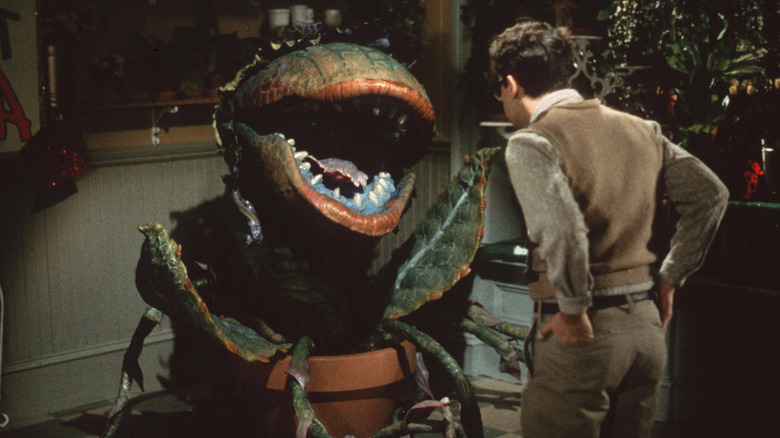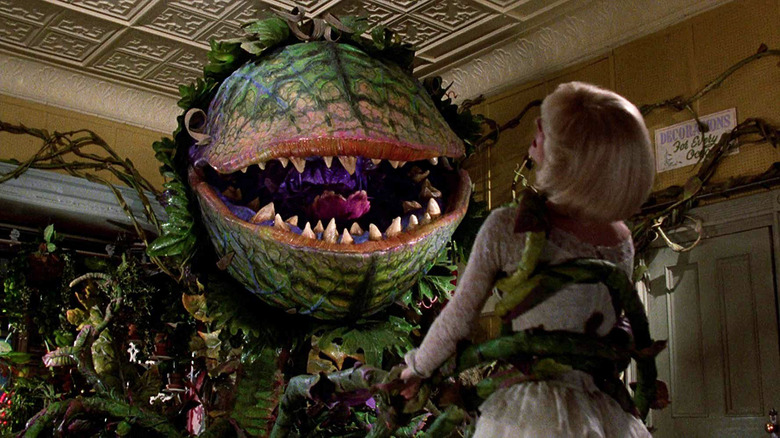The Budget For Little Shop Of Horrors Sparked A Battle With Warner Bros.
The 1986 musical "Little Shop of Horrors" started its life as a zero-budget monster comedy that Roger Corman legendarily shot over the course of two days and a single night. Rehearsals were only held for the three days prior, and it was filmed on sets that had been left standing for the production of "A Bucket of Blood," which had just wrapped filming. A young Jack Nicholson appears in the film as a masochistic dental patient. The 1960 film is a prime example of low-budget tenacity at work — all one needs is gumption, a portion of an idea, and a few actors willing to read lines.
The film is about a nebbish named Seymour (Jonathan Haze) who discovers a talking alien plant (Charles B. Griffith) that thirsts for human flesh. In order to appease his boss and impress his would-be girlfriend Audrey (Jackie Joseph), he feeds the plant his own blood and, when that became unfeasible, random drifters. The film ends with the plant, nicknamed Audrey. Jr., eating most of the principal cast.
After Nicholson achieved a greater level of fame about a decade later, Corman's 72-minute opus began making the midnight movie circuit, and, later, achieved infamy on the then-nascent VHS market. By 1982, the film had become notorious enough to warrant a winking, ironic Off-Broadway musical adaptation with music by the legendary Alan Menken and a book by Howard Ashman. The Audrey plant, redubbed Audrey II, was, in most productions, achieved with stellar advances in puppetry.
In 1986, the musical was then adapted back to cinemas by director Frank Oz who, in keeping with the stage production, employed some of the best puppeteering ever seen in a feature film. The reported budget to realize the on-screen version of Audrey II, was $25 million.
Warner Bros., naturally, balked.
The $25 million price tag
According to a 2021 retrospective of "Little Shop of Horrors" from the Hollywood Reporter written in celebration of the film's 35th anniversary, Frank Oz revealed some of the studio deals — made with producer David Geffen — that took place during production. Notably, Oz was asked to make a relatively low-budget movie, perhaps to fall in line with its Cormanian zero-money origins. Geffen's proposed budget was a mere $9 million. Oz had only co-directed two films prior to "Little Shop" ("The Dark Crystal" and "The Muppets Take Manhattan"), each of them with Jim Henson. This was to be his first feature as a solo director, and he had no mind for budgets. He said as much:
"I said, 'David, I don't work that way, I don't know how to write that way. I am not a budget person, and no one has ever budgeted a movie like this with a plant like this.' It went way over budget as a result."
Way, way over budget. Like almost triple the $9 million Geffen wanted. "Little Shop" was losing money so quickly, Oz began betting calls from over Geffen's head. Evidently, Terry Semel, the co-SEO of Warner Bros. gave the director a ring to find out what was happening. It was not a pleasant conversation, as Oz recalls:
"He would say, 'Frank, what the **** are you doing with that much money?' And I kept on saying, 'We are doing the best we can' because I had never done it before. Finally, Terry said, 'I am coming to London.' And I said, 'Terry, don't do that because we'll buffalo you. You don't know enough about it. Send your best production budget guy over instead.'"
As a negotiation, Oz could show what he had been doing.
'They are doing the best they can.'
The WB "production budget guy," unnamed in the retrospective, did indeed come to London where Frank Oz was filming to look over the production. It seems that the studio visitor found "Little Shop of Horrors" to be a case of intricate special effects, and not an instance of wonton wastefulness or a neophyte director being foolish. Everything, it seems, was being spent well. The budget guy returned to the United States to essentially repeat what had already been said. Recalls Oz:
"And that's what he did. The guy came over for about a week, went through every single department, and at the end, he said the same thing: 'They are doing the best they can.'"
One instance of budget run amok was, as fans of the film know, the unused ending. Over the course of "Little Shop of Horrors," Seymour (Rick Moranis) achieved fame and affection from Audrey (Ellen Green) by feeding blood, then bodies, to Audrey II (voiced by Levi Stubbs). In the final theatrical cut, Audrey II had grown to enormous sizes and announced a plan for world domination, causing Seymour to attack and electrocute the plant to death. In the original cut of the movie, Audrey II ate Seymour and Audrey, broke out of the building into the streets, and did indeed take over the world in an expensive, 23-minute kaiju sequence.
The ending was rewritten when test audiences found it to be too depressing.
But, otherwise, Oz really did his best. The film's special effects are still impressive to this day, and Oz would go on — now savvier — to direct numerous other comedy hits including "Dirty Rotten Scoundrels," "What About Bob?," "In & Out," and "Bowfinger."


